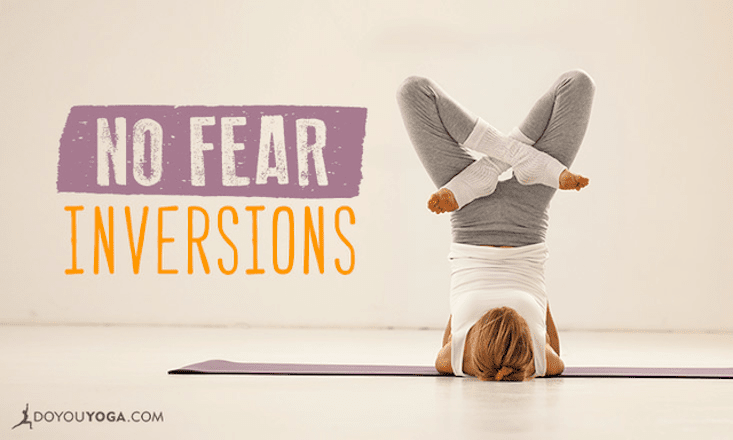Turning your world upside down can feel scary. As children, we found it easy to hang upside down, but as we enter adulthood this simple and fun, playful quality is often forgotten.
When we start practicing as adults, we can be scared of inversions and getting upside-down can even feel impossible. But inversions are nothing to be fearful of! Especially since inversions are not just about handstands in the middle of a room. You can get the benefits of inversions already by simply lifting your legs up the wall!
Benefits of Inversions
An inversion is a posture where the head is below the heart, and this is generally very invigorating for the body and the mind. When our head and heart are lower than the rest of the body, there is an increased flow of blood moving to the brain, providing us more energy and clearer thoughts.
Inversions can be helpful for headaches and insomnia, and they soothe the nervous system as well. When we get upside down, the lymphatic fluids can flow from the legs and feet, which reduces swollen feet. The more active versions of inversions, such as handstand and shoulder stand, build core strength and confidence as you work your way up.
Working Your Way Up
When starting with inversions, you should not attempt to hoist yourself up to a handstand, but to start slowly to explore the world where the feet are up.
1. Legs Up the Wall (Viparita Karani) is an easy pose to start with, especially when done against a wall. It is a very restorative pose, and as such quite easily available. But just because the pose is very easy, does not mean its without wonderful benefits!
When we lift up our legs on the wall, we increase the blood circulation to the upper body, relieve swollen feet and legs, calm the mind and rebalance the entire body. This is a perfect way to get used to being upside down.
Start by taking the mat against the wall, and enjoying having the feet up. You can stay in this pose 5 to 10 minutes as often as you would like.
2. Supported Shoulder Stand (Salamba Sarvangasana) is helpful for strengthening the upper body, legs, and abdomen while stretching the neck and the shoulders. Here the same rules apply as with any inversion: take it step by step instead of just trying to get into the full pose immediately.
The Supported Shoulder Stand is easy to practice against a wall. Start in Viparita Karani, Legs Up the Wall. Bring the bottoms of your feet against the wall, bending your knees slightly. Hands are by your side, firmly on the ground. From here, start slowly lifting your hips up, firmly rooting your feet onto the wall. Once you're up, bring your hands behind your lower back for support.
Try to have your feet on the same level as your knees, or higher. However, don't adjust yourself when in the pose! Come slowly back down in a controlled manner, adjust your feet, and go back up again. Avoid also moving your head when you are in the pose.
If you feel comfortable once in the pose, you can lift one leg at a time away from the wall, towards the ceiling. This will give you an idea of what it feels like to be in the full pose of Salamba Sarvangasana.
To get into the full pose, you can bring both legs up towards the ceiling. Stay for 2 to 4 breaths to begin with. Slowly come down by placing your feet back on the wall, and lowering yourself onto the mat.
3. Supported Headstand (Salamba Sirsasana ) can leave you feeling energized while it strengthens the spine, neck, and shoulders. It also tones the abdominal muscles and improves posture. And best of all, it's not as difficult to start with as you might think!
Start by bringing the short side of your mat next to the wall. Come onto a Child's Pose so that your toes are touching the wall. Make sure that your hands are shoulder width apart by taking a hold of your elbows with your hands. Without moving your elbows, interlace your hands, bring the crown of your head inside your forearms and rise up to a Dolphin (Down Dog on your forearms). Your toes should be on the floor and heels up the wall.
From here, start slowly walking your feet up the wall. Try to have your hips directly above your shoulders, so that you form an 90 degree angle with your feet on the wall. This may take some getting used to, so just practice slowly and strengthen the shoulders and upper arms.
When should you not invert?
If you have high blood pressure, or recent back or neck injury, it's advised to avoid inversions.
For women who are menstruating it's better to avoid the more heavy inversions. The body is working hard to bring the flow downwards, and bringing your body upside down may disturb this natural process. So for those few days a months, take it easy, enjoy a more restorative practice and stick to gentle inversions, like Legs Up the Wall.
Inversions are nothing to be fearful of, especially when you start slowly and build your way up. We should never attempt poses when we are stiff from fear to begin with, so explore the world of up-side-down, give yourself time, get playful and enjoy the new perspectives these poses can give you!


